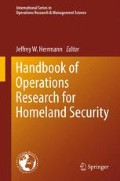Abstract
This chapter presents a simulation model that can be used to prepare for a bioterrorism attack that releases anthrax spores and exposes thousands of persons to this deadly disease. The model predicts the expected number of deaths using information about the size of the population, the number exposed, the progress of the disease, the resources available for distributing medication and treating the ill, and the size of local medication stockpiles. The chapter also presents a risk management approach for allocating a limited medication stockpile to multiple cities to minimize the expected number of deaths. The results show that the optimal allocation can be quite different from allocations that are proportional to population size.
Access this chapter
Tax calculation will be finalised at checkout
Purchases are for personal use only
References
Bicknell WJ (2003) How best to fight against bioterrorism. http://www.cato.org/pub_display.php?pub_id=3189. Accessed 8 June 2011
Bier VM, Haphuriwat N, Menoyo J et al (2008) Optimal resource allocation for defense of targets based on differing measures of attractiveness. Risk Anal 28:763–770
Brandeau ML, Zaric GS, Freiesleben J, Edwards FL, Bravata DM (2008) An ounce of prevention is worth a pound of cure: improving communication to reduce mortality during bioterrorism responses. Am J Disaster Med 3:65–78
Centers for Disease Control and Prevention (2007) Emergency MedKit evaluation study summary. http://www.bt.cdc.gov/agent/anthrax/prep/pdf/medkit-evaluation-summary-2007.pdf. Accessed 7 June 2011
Centers for Disease Control and Prevention (2011) Cities readiness initiative. http://www.bt.cdc.gov/cri/. Accessed 7 June 2011
Cox LA (2009) Game theory and risk analysis. Risk Anal 29:1062–1068
Graham B, Talent J, Allison G, Cleveland R, Rademaker S, Roemer T, Sherman W, Sokolski H (2008) World at risk: the report of the commission on the prevention of WMD proliferation and terrorism. Vintage Books, New York
Holty JE, Bravata DM, Liu H, Olshen RA, McDonald K, Owens DK (2006) Systematic review: a century of inhalational anthrax cases from 1900 to 2005. Ann Intern Med 144:270–280
Houck ML (2011) Compartmental and simulation models for evaluating MedKit prepositioning strategies for anthrax attack response. University of Maryland, College Park, MD
Houck ML, Herrmann JW (2011) Predicting the impact of placing pre-event pharmaceuticals for anthrax. Technical report. Institute for Systems Research, University of Maryland, College Park, MD
Institute of Medicine (2008) Dispensing medical countermeasures for public health emergencies. Workshop summary. Institute of Medicine Forum on Medical and Public Health Preparedness for Catastrophic Events, National Academies Press, Washington, DC
IOM (Institute of Medicine) (2012) Prepositioning antibiotics for anthrax. The National Academies Press, Washington, DC
Jacquez JA (1996) Compartmental analysis in biology and medicine, 3rd edn. BioMedware, Ann Arbor, MI
Kinlaw K, Barrett DH, Levine RJ (2009) Ethical guidelines in pandemic influenza: recommendations of the Ethic Subcommittee of the Advisory Committee of the Director, Centers for Disease Control and Prevention. Disaster Med Public Health Prep 3:S185–S192
National Biodefense Science Board (2008) Excerpts from the summary report of the National Biodefense Science Board. http://www.phe.gov/Preparedness/legal/boards/nbsb/Documents/nbsb-excrpt-pp-080618.pdf. Accessed 6 July 2011
Oren M (2009) Biological agents and terror medicine. In: Shapira SC, Hammond JS, Cole LA (eds) Essentials of terror medicine. Springer, New York
Richter A, Khan S (2009) Pilot model: judging alternate modes of dispensing prophylaxis in Los Angeles County. Interfaces 39:228–240
Shepard CW, Soriano-Gabarro M, Zell ER et al (2002) Antimicrobial postexposure prophylaxis for anthrax: adverse events and adherence. Emerg Infect Dis 8:1124–1132
Stern PC, Fineberg HV (eds) (1996) Understanding risk: informing decisions in a democratic society. National Academy Press, Washington, DC
Troy T (2010) Preparing for bioterrorism. Weekly Standard, 23 Feb 2010. http://www.hudson.org/index.cfm?fuseaction=publication_details&id=6785. Accessed 8 June 2011
Walter GG, Contreras M (1999) Compartmental modeling with networks. Birkhäuser, Boston
Wein LM, Craft DL, Kaplan EH (2003) Emergency response to an anthrax attack. Proc Natl Acad Sci USA 100:4346–4351
Werner K, Deasy J (2009) Acute respiratory tract infections: when are antibiotics indicated? J Am Acad Phys Assist 22:22–26
Willis HH, Morral AR, Kelly TK et al (2005) Estimating terrorism risk. RAND Corporation, Santa Monica. http://www.rand.org/pubs/monographs/2005/RANDMG388.pdf
Zaric GS, Bravata DM, Holty JC, McDonald KM, Owens DK, Brandeau ML (2008) Modeling the logistics of response to anthrax bioterrorism. Med Decis Making 28:332–350
Acknowledgments
The author received no external funding for this study. The author gratefully acknowledges the contributions of Michelle L. Houck, who constructed mathematical models and collected numerical results using these models to predict the impact of predispensing medical countermeasures.
Author information
Authors and Affiliations
Corresponding author
Editor information
Editors and Affiliations
Rights and permissions
Copyright information
© 2013 Springer Science+Business Media New York
About this chapter
Cite this chapter
Herrmann, J.W. (2013). Mitigating the Risk of an Anthrax Attack with Medical Countermeasures. In: Herrmann, J. (eds) Handbook of Operations Research for Homeland Security. International Series in Operations Research & Management Science, vol 183. Springer, New York, NY. https://doi.org/10.1007/978-1-4614-5278-2_7
Download citation
DOI: https://doi.org/10.1007/978-1-4614-5278-2_7
Published:
Publisher Name: Springer, New York, NY
Print ISBN: 978-1-4614-5277-5
Online ISBN: 978-1-4614-5278-2
eBook Packages: Business and EconomicsBusiness and Management (R0)

